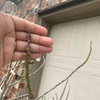Pests. Arrgggh.
erict
15 years ago
My gardenia has already fought spider mites months ago. Now, some leaves are bitten off, and the general "there's spotty stuff on the leaves" look is back. (Proceeds to spray plant with heavy pesticides).
The very same day, a minirose (keep in mind they are both outdoors and in pots) had about....75% of it's leaves munched on. Grey spots are everywhere any will turn into holes.
I want every insect within five feet of these plants turned to dust. How do I do it?

luis_pr
erictOriginal Author
Related Professionals
Maple Valley Landscape Architects & Landscape Designers · New Bedford Landscape Architects & Landscape Designers · Cottonwood Landscape Architects & Landscape Designers · Buford Landscape Contractors · Aloha Landscape Contractors · Arden-Arcade Landscape Contractors · Brownsville Landscape Contractors · Downey Landscape Contractors · East Haven Landscape Contractors · Ocoee Landscape Contractors · Rockwall Landscape Contractors · Tewksbury Landscape Contractors · Wayland Landscape Contractors · Wheat Ridge Landscape Contractors · Bakersfield Swimming Pool Buildersjeff_al